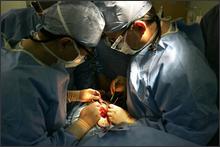|
武汉大学校友论坛
难忘珞珈 湖医87级研究生 湖医79级 湖医88级 寻人购物区
|
医学部校友肖传国教授应邀赴美为截瘫病人做手术AP 贴于2006/12/19 23:40 (武汉大学校友论坛)
HEALTH/SCIENCE Monday, December 18, 2006 · Last updated 6:43 p.m. PT Rerouting nerves may aid bladder control By LAURAN NEERGAARD AP MEDICAL WRITER WASHINGTON -- Needing a wheelchair isn't always the biggest complaint of people left paralyzed by spinal cord injury - it's also the loss of bladder control. On Monday, Michigan doctors began a unique experiment to see if rerouting patients' nerves just might fix that problem. It's a delicate operation: Surgeons cut open a spot on the spine and sew two normally unrelated nerves together - one from the bladder to one from the thigh - with a single hair-thin stitch. It will take months for this new nerve bridge to heal, an anxious waiting period for the first volunteers. But if it works, merely scratching the thigh should signal the bladder to empty, allowing patients to ditch their despised catheters and restore a longed-for degree of freedom, as well as fewer bladder infections and other serious complications. "I've got nothing to lose by doing this," is the way a cautiously hopeful Kevin Bryant, 19 and paralyzed from the waist down by a car crash, approached the experiment. It's a technique pioneered in China that is starting to garner international attention - and surgeons at William Beaumont Hospital in Royal Oak, Mich., hope their new U.S. study will prove if the approach really is a solution for at least some patients. "We're very excited," says Dr. Kenneth Peters, Beaumont's urology research chief, who headed a team of doctors that traveled to China last February to watch Dr. Chuan-Gao Xiao operate at the Huazhong University of Science and Technology. "We said, 'This is something we need to study ... to see if we can reproduce this in the U.S.,'" adds Peters, who in turn invited Xiao into Beaumont's operating room Monday. If the results hold up, "it would allow us to treat those patients who have no other alternatives." Monday's first volunteer: a 49-year-old paralyzed from a car crash, Kevin Conkey of Fenton, Mich. On Thursday, Bryant, the 19-year-old paraplegic, undergoes the procedure - in addition to a child with spina bifida, an improperly formed spinal cord that can cause similar bladder dysfunction. After infancy, the brain takes over control of urination. The bladder sends "I'm full" signals up the spinal cord. Once the person's in an appropriate spot, the brain signals back to the bladder to empty. In spinal cord injury and spina bifida, that control is disrupted, leaving patients either unable to urinate or constantly wet. They depend on catheters to empty the bladder every few hours. Still, recurrent infections and even lifethreatening kidney damage from backed-up bladders are common, not to mention the inconvenience and even embarrassment the procedure brings. "People put so much emphasis on walking. I don't care if I walk again; that's not the No. 1 thing," says Bryant, of Rochester Hills, Mich. Going to the bathroom is "such a hassle in day-to-day life. I have to schedule my life around the times when I'm going to catheterize."
|
